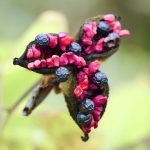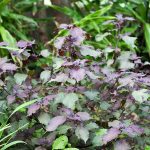
The genus Tanacetum of the family Asteraceae are a widespread group of plants throughout Europe and West Asia. There are about 200 species. The commonly grown garden plants are feverfew (T. parthenium) and tansy (T. vulgare) which have important medical properties. Not all the species have been characterised.
Each species shows considerable variation in the major constituents of their essential oils. Common chemicals though are camphor, borneol, caryophyllone oxide, sabinene, isopulegone, 1,8-cineole, thymol, trans-sabinyl acetate, alpha-thujone, and carvone. Presented here are some of those that have been analysed.
Tanacetum cadmeum
(see Gogus et al., 2009).
Tanacetum sorbifolium
The oil obtained by hydrodistillation from the aerial parts of Tanacetum sorbifolium (Boiss.) Grierson from Turkey was analysed by gas chromatography- mass spectroscopy (GC-MS) (Özer et al., 2006). Twenty-nine components were characterized, representing 91.0% of the total components detected. The major constituents were identified as camphor (54.3%), pinocarvone (5.1%), chrysanthenone (4.7%), bornyl acetate (3.9%) and camphene (3.4%).
Tanacetum (syn. Chrysanthemum) fruticulosum Ledeb
The essential oil of Tanacetum (syn. Chrysanthemum) fruticulosum Ledeb. from Iran was investigated by gas chromatography (GC), with mass spectroscopy (GC–MS) and nuclear magnetic resonance (NMR) spectroscopy. The oil was characterized by the presence of some photo-oxidation products from lavandulol and nerolidol. Ninety-seven components, representing 93% of the oil, could be identified. The oil contained mainly monoterpenes [1,8-cineole, camphor, lavandulol, lavandulyl acetate]. A new group of compunds were identified; 5-isopropenyl-2,2-dimethyltetrahydrofuran-3-yl-methyl acetates which were trace constituents. Some new farnesyl derivatives [3,6;6,9-bisepoxyfarnesa-1,7(14),10-trienes, 7,10-epoxyfarnesa-1,5,11-trien-3-ols, 6,9-epoxyfarnesa-1,7(14)10-trien-3-ol were identified from their NMR spectra (Weyerstahl et al., 1999).
Tanacetum aucheranum and Tanacetum chiliophyllum var. chiliophyllum
The chemical composition of essential oils isolated from the aerial parts by hydrodistillation of Turkish Tanacetum aucheranum and Tanacetum chiliophyllum var. chiliophyllum was analyzed by gas chromatography – mass spectroscopy (GC–MS). The oils contain similar major components. The major components of T. aucheranum oil were 1,8-cineole (23.8%), camphor (11.6%), terpinen-4-ol (7.2%), α-terpineol (6.5%), borneol (3.8%), (E)-thujone (3.2%), epi-α-cadinol (3.1%), and artemisia ketone (3.0%). Camphor (17.9%), 1,8-cineole (16.6%) and borneol (15.4%) were found to be predominant constituents in the oil of T. chiliophyllum. It is interesting to find that ester derivatives of dihydro-α-cyclogeranic acid (2,2,6-trimethylcyclohexylcarboxylate), dihydro-α-cyclogeranyl hexanoate (10.1%), dihydro-α-cyclogeranyl pentanoate (3.0%), dihydro-α-cyclogeranyl butanoate (2.1%) and dihydro-α-cyclogeranyl propionate (1.2%) are firstly found as chemotaxonomically important components in T. chiliophyllum oil. From these, dihydro-α-cyclogeranyl hexanoate was isolated on silica gel column chromatography and its structure was confirmed by spectroscopic methods. This was the first report on the occurrence of ester derivatives of dihydro-α-cyclogeranic acid in essential oils of Tanacetum species. The oils were also characterized to have relatively high amounts of oxygenated monoterpenes. Results of the antifungal testing by microbial growth inhibition assays showed that the oils completely inhibit the growth of 30 phytopathogenic fungi. However, their growth inhibition effects were lower than commercial benomyl.


Leave a Reply